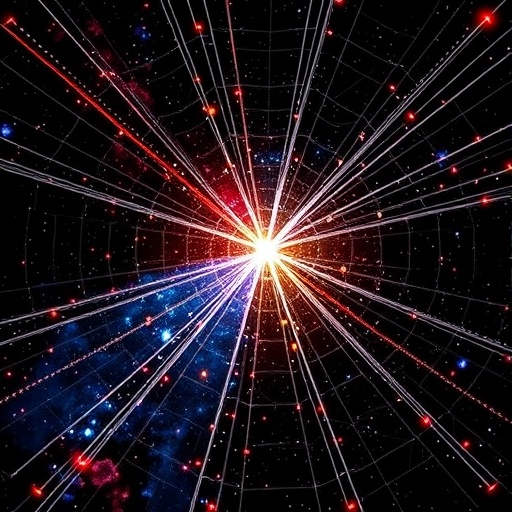In the sprawling quest to unveil the enigmatic nature of the cosmos, dark matter remains one of the most tantalizing puzzles in modern physics. It is an invisible and elusive substance believed to constitute approximately 27% of the universe’s mass-energy content, silently orchestrating the gravitational choreography of galaxies. Despite its profound influence on cosmic structure, direct detection of dark matter has evaded scientists for decades, primarily due to its feeble interaction with ordinary matter. However, recent advancements from researchers at Tohoku University introduce a groundbreaking approach poised to revolutionize the sensitivity of dark matter detection using quantum sensor networks.
At the heart of this pioneering study lies the exploitation of quantum mechanics — a domain governing the bizarre behavior of particles at the smallest scales. Quantum sensors harness these principles to sense minuscule signals with unparalleled precision, vastly outperforming traditional detection methods. The researchers innovatively propose linking superconducting qubits, which are quantum bits realized through minuscule superconducting circuits kept at ultra-low temperatures, into optimized network architectures. This interconnected system amplifies their collective sensitivity, surpassing what solitary sensors could achieve individually.
Superconducting qubits, conventionally celebrated as the fundamental building blocks for quantum computers, manifest exceptional coherence and controllability, making them attractive candidates for sensitive detection instruments. By arranging these qubits into specific graph structures—such as rings, chains, star configurations, and fully connected networks—the team demonstrates that the topology of the network significantly influences measurement efficacy. Each configuration manipulates quantum correlations and entanglement in unique ways, enhancing the ability to distinguish faint dark matter-induced signals from background noise.
To navigate the complexity of optimizing these quantum sensor networks, the researchers deploy a sophisticated technique known as variational quantum metrology. This method draws parallels with training algorithms used in machine learning, iteratively adjusting the way quantum states are prepared, evolved, and measured to maximize precision. By tailoring the entanglement and measurement protocols, the team systematically uncovers network configurations that push the boundaries of sensitivity, edging closer to fundamental quantum measurement limits.
The noisy realities of experimental conditions present formidable challenges, often degrading the potential advantages of quantum sensors. Addressing this, the team incorporates Bayesian estimation techniques as a statistical tool to refine their data analysis. Bayesian inference acts akin to an intelligent filter, meticulously extracting credible signals from noisy data. This method effectively sharpens the blurred quantum measurements, ensuring robust detection outcomes even amidst practical imperfections.
Experiments conducted on networks consisting of four and nine superconducting qubits reveal remarkable consistencies. Optimized quantum sensor networks consistently outperform classical counterparts, retaining enhanced sensitivity despite realistic noise. This empirical validation bodes well for the practical implementation of such devices on contemporary quantum hardware, suggesting immediate applicability beyond theoretical constructs.
Lead researcher Dr. Le Bin Ho underscores the impetus behind the study, stating, “Our ambition was to systematically design and fine-tune quantum sensor networks to detect the almost imperceptible signals potentially generated by dark matter interactions. The architecture of these networks plays a critical role in elevating sensitivity, and our work proves that this enhancement can be accomplished using relatively simple qubit configurations.”
The implications of this research transcend the elusive hunt for dark matter detection. Quantum sensor networks optimized in this manner could revolutionize a broad spectrum of cutting-edge technologies. They present promising prospects in quantum radar systems, which aim to detect objects with supreme precision; gravitational wave observatories, where tiny spacetime distortions demand extraordinary measurement sensitivity; and atomic clocks, essential for timekeeping standards at unprecedented accuracies.
Potential future applications might ripple into everyday technology and critical infrastructure. Enhancements in GPS accuracy, improved medical imaging like MRI scans with deeper insights into brain function, and even the detection of hidden subterranean formations could all benefit from the enhanced resolution afforded by quantum sensor networks. Such advances punctuate the enormous societal impact quantum technologies may have beyond pure scientific inquiry.
One of the most fascinating aspects of this research is the demonstration that relatively accessible quantum circuits can be harnessed to achieve these dramatic improvements, instead of relying on presently infeasible large-scale, noiseless quantum computers. This pragmatic pathway accelerates the timeline for real-world deployment of quantum-enhanced sensing technologies, transforming how we interface with the subtle fabric of reality.
Looking forward, the researchers aim to scale their approach to encompass larger and more complex quantum networks. They are also investigating methods to further bolster sensor resilience against environmental noise, an omnipresent challenge that threatens the fidelity of quantum measurements. Such efforts could see the rise of robust quantum sensor arrays operational outside pristine laboratory settings, bridging the gap between theoretical promise and practical utility.
By pioneering optimized network structures for superconducting qubits, this study fundamentally reshapes the landscape of precision measurement. It demonstrates how quantum technologies can stretch the frontiers of what is currently measurable, ultimately bringing humanity closer to unraveling the dark components of our universe while catalyzing revolutionary technological advancements across diverse fields.
The comprehensive findings of this research were published in Physical Review D on October 1, 2025, marking a milestone in the amalgamation of quantum information science and astrophysical exploration.
Subject of Research: Dark Matter Detection via Quantum Sensor Networks
Article Title: Optimized quantum sensor networks for ultralight dark matter detection
News Publication Date: October 1, 2025
Web References: DOI: 10.1103/rv43-54zq
Image Credits: ©Tohoku University
Keywords: Dark matter, Quantum mechanics, Quantum computing, Qubits, Bayesian inference




